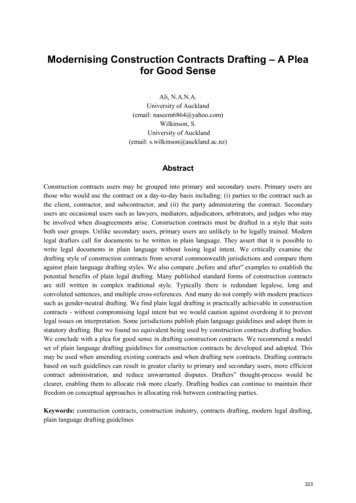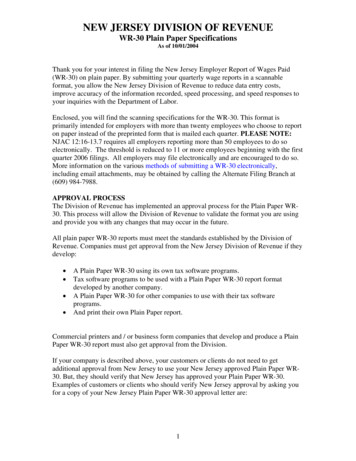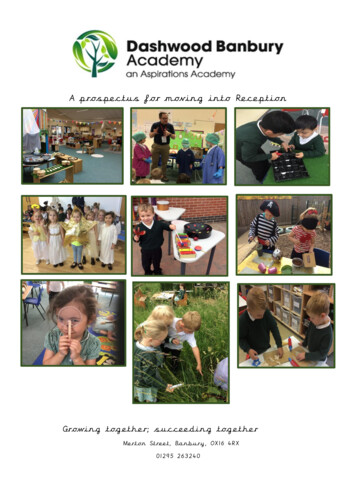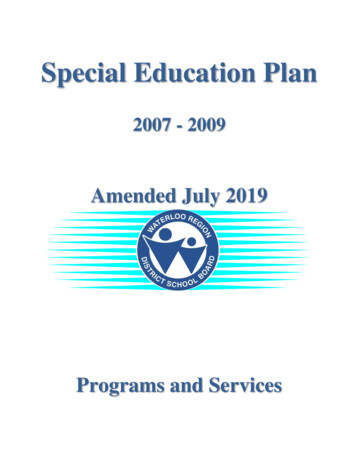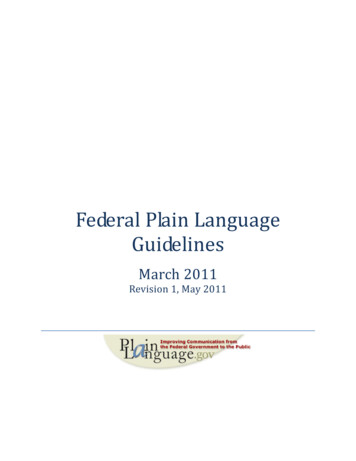
Transcription
SPECIAL EDUCATION IN PLAIN LANGUAGE sp
SPECIAL EDUCATION IN PLAIN LANGUAGE 2014This Guide contains general information and does not constitute individual legal advice about your situation.You should consult with an attorney for individual legal advice about your situation and to find out how thisinformation applies to your situation. 2009 Special Education Task ForceUpdate 2013 Special Education Task ForceUpdated 2014 Special Education Task ForceThe authors gives permission to freely reproduce this guide if it is copied and provided without alteration in itsentirety.2
SPECIAL EDUCATION IN PLAIN LANGUAGE 2014TABLE OF CONTENTSPreface . . . .4Acknowledgment . . . .5General Information . . . .6The Special Education Process . . . .7Overview of the Special Education Process . . . .8Initial Referral for Special Education Services . . . .9Committee on Special Education . . . .12Individualized Education Program . . . .14Annual Review/Reevaluation . . . .16Timelines . . . .17Least Restrictive Environment/Continuum of Services .18Transition . .19Assistive Technology . 21Special Transportation . .22Your General Rights as a Parent . .23What Are My Rights to Access My Child’s Educational Records?. 24Independent Educational Evaluation . 25Consent . . 26Due Process Rights .27Prior Written Notice . . 28Mediation . . 29Impartial Due Process Hearings . . .30Resolution Session. . . .32New York State Education Department Complaint . . 35U.S. Department of Education Complaint . .37Section 504 Accommodation Plan. . . . .38General School Discipline Issues. . .42Disciplining Students with Disabilities. . 46Sample Letters . .50Resources . .573
SPECIAL EDUCATION IN PLAIN LANGUAGE 2014PREFACEThe Special Education TaskForce is comprised of over 200 parent advocates, school district staff,attorneys and other individuals who specialize in Special Education Law, and work collaboratively toensure that children with disabilities are educated in the least restrictive setting and receive a free andappropriate education. The Special Education TaskForce works to assure that families and school personnel have the knowledge and skills to enable them to effectively assist students with disabilities. Tothis end, this publication was developed to help families and educators to work collaboratively in supporting students with disabilities throughout their school years.Parents and family members are important partners, along with school district personnel, in theeducation of children with disabilities. Parents provide necessary information to teachers and administrators, play an important role in decisions made about their children and participate as a full member of theCommittee on Special Education. In order for families to have a meaningful role in their children’s education they must understand their rights and responsibilities in special education.This publication provides information for parents and families about laws, regulations, and policies affecting special education programs and services. Our hope is that through the use of this publication, parents, families and school districts will collaborate together in order to help students reach theirfull potential. Developing this publication has taken the collaborative efforts of many dedicated individuals, organizations and school district personnel. This document is a reflection of the collaboration that ispossible when schools and advocates, administrators and families work together to meet our obligation tostudents with disabilities.Jennifer J. MonthiePrincipal AuthorThe publication was last updated 09/25/144
SPECIAL EDUCATION IN PLAIN LANGUAGE 2014ACKNOWLEDGMENTMany members of the Special Education TaskForce which include parents, advocates, and school districtpersonnel assisted in the development of this publication. We specifically acknowledge and thank:Principal AuthorJennifer Monthie, Esq.DISABILITY RIGHTS NEW YORK725 Broadway, Suite 450Albany, New York 12207(518) 432-7861Contributing Authors and EditorsTina BeauparlantParent to Parent of NYS500 Balltown RoadSchenectady, New York 12304(518) 381-4370Julie Michaels Keegan, Esq.DISABILITY RIGHTS NEW YORK725 Broadway, Suite 450Albany, New York 12207(518) 432-7861Robin HickeyDevelopmental Disabilities Planning Council99 Washington Avenue12th Floor, Suite 1230Albany New York 12210(518) 486-7505Kim WadsworthNY Justice Center161 Delaware AveDelmar, New York 12054(800) 624-4143Layna MaherNY Justice Center161 Delaware AveDelmar, New York 12054(800) 624-4143Lisa Isaacs, Esq.New York Lawyers for the Public Interest151 West 30th Street11th FloorNew York, New York 10001(212) 244-4664Prior Version Contributing Authors and EditorsMichael Grau, Psy. D.Judy Swierczewski, Esq.Noreen M. Walker5
SPECIAL EDUCATION IN PLAIN LANGUAGE 2014GENERAL INFORMATIONThis publication includes imbedded citations to New York State and Federal education laws and administrativedecisions from the New York Office of State Review and the New York State Commissioner of Education. Citation to New York State Education Law:The NY Educ. Law Article 85 and 89 can be found at MONQUERY LAWS. Citation to New York State Commissioner’s Regulations:The Commissioner’s Regulations can be found at Title 8 of the State of New York Codes, Rules and Regulations Part 200 and 201 (8 NYCRR 200-201). For a copy of these regulations please go to New York State Education Department (NYSED) web-site or 0.htm Citation to Family Educational Rights and Privacy Act:This publication includes citations to the Family Educational Rights and Privacy Act, 20 U.S.C.A. 1232 g(1974) and its implementing regulations at 34 C.F.R. 300.613(2006) and 34 C.F.R. 99 (2008). For a copy ofthese regulations please go to .html Citation to State Review Officer Decisions:The State Review Officer’s written decisions may be found at http://www.sro.nysed.gov/ Citation to New York State Commissioner of Education Decisions:The Commissioner of New York State Education Department decisions may be found at http://www.counsel.nysed.gov/Decisions/ Citation to Section 504 of the Rehabilitation ActSection 504 of the Rehabilitation Act, 29 U.S.C. 794, and its implementing regulations at 34 C.F.R. 104 canbe found at tyoverview.html6
SPECIAL EDUCATION IN PLAIN LANGUAGE 2014THE SPECIAL EDUCATION PROCESSWhat is Special Education?Special education means specially designed individualized or group instruction or special services orprograms to meet the unique needs of students with disabilities. Special education services and programs are provided at no cost to the parent. 8 NYCRR 200.1 (ww) * please see page 6What are the steps in the Special Education Process?Step 1: Initial Referral for Special Education ServicesStudents suspected of having a disability are referred to a multidisciplinary team called the Committeeon Preschool Special Education (age 3– 5) or the Committee on Special Education (age 5-21). 8 NYCRR200.4 (a)Step 2: Individual Evaluation ProcessThe Committee arranges for an evaluation of the student’s abilities and needs. 8 NYCRR 200.4(b)Step 3: Determining Eligibility for Special Education ServicesBased on evaluation results, the Committee, which includes the child’s parent, decides if the student iseligible to receive special education services and programs. 8 NYCRR 200.4 (c)Step 4: Individualized Education Program (IEP)If the child is eligible to receive special education services, the Committee develops and implements anIndividualized Education Program (IEP). The IEP is a document that describes the student’s needs, thespecial education supports and services the student will receive, and the student’s year long goals. TheCommittee must also determine the student's placement, ensuring that services are provided in the leastrestrictive environment (LRE). Placement must be as close as possible to the student's home, and unlessthe student's IEP requires some other arrangement, the student must be educated in the school he or shewould have attended if not disabled. 8 NYCRR 200.4 (d)(2); 8 NYCRR 200.4 (d)(4)(ii)(b)Step 5: Annual Review/ReevaluationThe Committee must review the IEP at least once a year (annual review). The student must be reevaluated at least once every three years. 8 NYCRR 200.4(f); 8 NYCRR 200.4(b)(14)Timelines are in place so that delays are avoided. (See Timelines Section) Parents are an integral part ofthis process and their involvement is strongly encouraged.7
SPECIAL EDUCATION IN PLAIN LANGUAGE 2014OVERVIEW OF THE SPECIAL EDUCATION PROCESSReferralAlthough this chart shows a series ofdecisions, all the decisions are connected. All the decisions are centeredon the needs of the child.EvaluationFor some children, all the CPSE/CSE’sdecisions can be made in one meeting.For other children, the Committee willneed to meet together more than once.Anyone on the Committee can ask formore time if it is needed. Anyone onthe Committee can also ask for anotherCPSE/CSE to be held if there arechanges to be talked about.CSE/CPSE Team Forms:Based on the type of CSE meeting being held theteam includes: parent, regular education teacher, special education teacher, school psychologist, parent member, district representative, andany other individual having knowledge or special expertise about the student.Committee Decides:1. Does the child have an educational disability?2. Does the child need Special Education services?Committee writes the IEP together. This includesdeciding what services the child needs.Committee decides on the student’s program andplacement.The Committee reviews the student’s IEP at leastonce every school year.Committee does a reevaluation of the student at leastevery three years or more frequently if parents andschool agree, but not more that one time per year.8
SPECIAL EDUCATION IN PLAIN LANGUAGE 2014INITIAL REFERRAL FOR SPECIAL EDUCATION SERVICESWhat should you do if you feel your child needs special education?Preschool Children (Age 3-5)If your child is preschool age (3-5) and is not developing skills such as walking, talking or playing likeother young children, you may want to talk to the child’s doctor. He or she may be able to reassure youthat children develop at different rates and your child is within the normal developmental scales. If,however, the doctor is concerned, or you or your child’s teachers are still not comfortable with yourchild’s progress, you may wish to make a referral to the school district’s Committee on Preschool Special Education (CPSE). See Sample Letters Section.School-Age Children (Age 5-21)If you have a school-age child and you have noticed your child has been having difficulty in school youmay want to talk with your child’s teacher. Your child’s teacher may be able to help you understand theproblems your child is having in school. You may also talk with your child’s doctor. If your child’sdoctor, teacher or if you are still concerned about your child’s progress in school, you may wish to makea referral to your school district’s Committee on Special Education. See Sample Letters Section.What is response to intervention (RtI)?RtI is a process that your school district must use to try and determine if general education school-widesupports can effectively address your child’s need and prevent the need for your child to be classifiedfor special education services. A referral to RtI may also be called a referral to the Child Study Team(CST). RtI attempts to close the gap for all students, including students at risk, students with disabilitiesand English language learners, by addressing smaller learning problems so that they do not become insurmountable gaps. The process can also be used to gather data about your child to make more appropriate identification of your child’s learning issues and allow for more appropriate interventions for children with learning disabilities. RtI requires each school district to establish a plan and policies for implementing school-wide approaches and pre-referral interventions in order to address a student’s performance issues prior to referral for special education. Each school district must select and define thespecific structure and components of its RtI program, including: Criteria for determining the levels of intervention to be provided to students;Types of interventions;Amount and nature of student performance data that will be collected; andManner and frequency for progress monitoring. 8 NYCRR 100.2(ii)If you would like more information about the RtI process you should contact your child’s school districtprincipal or go to ver.htmDo I have to wait until the RtI process is completed before I can refer my child forspecial education?No, you can make a referral for special education and do not have to wait until the RtI process has beencompleted. A school district must follow the special education process timelines even if your child isbeing evaluated by the RtI process. See Timelines Section.9
SPECIAL EDUCATION IN PLAIN LANGUAGE 2014INITIAL REFERRAL FOR SPECIAL EDUCATION SERVICESWhat is a referral for special education?A referral is a written letter asking that the school district evaluate your child to determine if he or she needsspecial education services. The letter should be addressed to the chairperson of your school district’s Committee on Special Education or if you do not know your school district’s chairperson then it should be addressedto your school principal. 8 NYCRR 200.4(a)Who can make a referral for special education?A referral may be made by you, the parent, a professional staff member designated by your school district, alicensed physician, a judicial officer, or your child. 8 NYCRR 200.4(a)(1)(i)-(iv). Your child’s teacher may request that your child be referred for special education services but may not have the legal authority to make areferral. This means that the timelines that the school district must comply with (See Timelines Section) willnot start upon a teacher’s request for special education services. To assure that your child is evaluated in themost timely fashion you should make a written referral for your child to be evaluated for special education services.What must be included in my referral?The written letter should include: Your child’s name.Your child’s date of birth.Your address and telephone number.A request that the school district evaluate your child for special education services.Your reasons or concerns for requesting the evaluation.It is important to list all of your concerns which may include: academic, behavioral, physical and social problems and/or delays that your child is experiencing. The District must evaluate all areas of suspected disability.8 NYCRR 200.4You should keep a copy of this letter as well as any other written communications, for your records.See Sample Letters Section.Why does my child need to be evaluated and how long will an evaluationtake?If a student is being evaluated for the first time, the District must complete the evaluation within 60 days ofthe date you signed the permission to evaluate form. Therefore, you should make sure that you obtain andsign the “permission to evaluate form” immediately. 8 NYCRR 200.4(b)(7)The purpose of the evaluation is to find out whether your child has a disability and needs more support than isavailable through school-wide services. The evaluation will also help your school district understand whatkind of special education services and supports your child needs.10
SPECIAL EDUCATION IN PLAIN LANGUAGE 2014INITIAL REFERRAL EVALUATION PROCESSWhy does my child need to be evaluated?The purpose of the evaluation is to find out whether your child has a disability and needs more support than isavailable through school-wide services. The evaluation will also help your school district understand whatkind of special education services and supports your child needs.How long will an evaluation take?The school district must complete an initial evaluation within 60 days of receipt of a parent’s signed consent(permission to evaluate form) unless this time frame is extended by mutual agreement between the student’sparent and the school district. 8 NYCRR 200.4(b)(7) Therefore, you should make sure that you obtain and signthe “permission to evaluate form” immediately.What evaluations will be completed?The school district must use a variety of assessment tools and strategies, including information provided bythe parent, to determine if a student is eligible for special education supports and services. These individualevaluation must include at least: A physical evaluation of the student;An individual psychological evaluation, except when a school psychologist determines after an assessmentof a school-age student that further evaluation is unnecessary;A social history of the student;An observation of the student in the student’s learning environment (including the regular classroom setting) or, in the case of a student of less than school-age or out of school, an environment appropriate for astudent of that age, to document the student’s academic performance and behavior in the areas of difficulty; andAny other appropriate assessments or evaluations necessary to determine the physical, mental, behavioral,and emotional factors which contribute to the child’s suspected disabilities. For example, a functional behavioral assessment for a student whose behavior impedes his or her learning or that of others. 8 NYCRR200.4(b)(1)(i-v).The school district must ensure that: The evaluations used to assess the student are provided in the student’s native language or other mode ofcommunication;Evaluations are administered by trained and knowledgeable personnel;No single measure or assessment is used as the sole criterion for determining whether a student is a studentwith a disability or for determining an appropriate educational program for a student;The student is assessed in all areas related to the suspected disability; andThe results of the evaluation are provided to the parents in their native language or mode of communication at no cost to the parent. 8 NYCRR 200.4(b)(6)(i)(a-d).11
SPECIAL EDUCATION IN PLAIN LANGUAGE 2014COMMITTEE ON SPECIAL EDUCATION (CSE/CPSE) MEETINGWhat happens after the District completes its evaluation of my child?After the school district has completed the evaluation of your child a meeting must be held. The meetingis called a Committee on Special Education (CSE) meeting or an IEP Team meeting. If you child is apreschool student (age 3-5) the meeting is called a Committee on Preschool Special Education (CPSE)meeting. 8 NYCRR 200.4(c)Who are members of a CSE or IEP Team? 8 NYCRR 200.3(2)The Committee includes: You as the parent or caregiver; Your child (if you and the school district agree that it is appropriate for your child to attend thismeeting); A special education teacher; A general education teacher (if your child is or may be participating in general education program); A representative of the school district who is qualified to provide or supervise the provision of special instruction (this person is typically called a chairperson); Someone who can interpret the instructional implications of the evaluation (this person is typicallythe school psychologist). A parent member (this person is a parent in your school district whose child is receiving special education services) only if you or the school district request his or her presence in writing at least 72hours prior to the meeting. The school district physician, only if you or the school district request his or her presence in writingat least 72 hours prior to the meeting. Any other person having knowledge or special expertise about your child. You and the school district can invite anyone that you believe has special knowledge about your child to be a member ofthe committee on special education.What is the role of the parent member? Help bridge the gap between you and the CSEPromote mutual respectHelp you understand the CSE processSupport you as the parent of a child with a disabilityMaintain confidentialityThe parent member is not your personal advocate. If you are interested in assistance in advocating foryou or your child during a Committee meeting, please see the Resource section of this guide for a list oforganizations in your area.12
SPECIAL EDUCATION IN PLAIN LANGUAGE 2014COMMITTEE ON SPECIAL EDUCATION (CSE/CPSE) MEETINGWhat happens at the CSE/CPSE or IEP Team Meeting?After the evaluation is completed, your child’s evaluators will explain the test results and you will be invited as a member to a CSE/CPSE meeting to talk about the results. You should attend this meeting because you have important information to share about your child. If you cannot attend, you have the rightto request that the meeting be held at a mutually convenient time and location. The District must provide the opportunity to participate by phone if you are unable to attend in person. At the meeting, theCommittee will review the evaluation results. Based on that information, and information that you provide, the Committee decides if your child is eligible or ineligible to receive special education programsand/or services. 8 NYCRR 200.4(c)In order to be eligible a child must be identified as having a disability because of mental, physical or emotional reasons that affects his/her ability to learn. 8 NYCRR 200.1(zz) The Committee must determine ifyou child falls into one of the following classifications: Autism;Deafness:Deaf-blindness;Emotional disturbance;Hearing Impairment;Learning disability;Intellectual disabilities;Multiple disabilities;Orthopedic Impairment; Other Health-impairment;Speech or language impairment;Traumatic brain injury; andVisual impairment includingblindness. 8 NYCRR 200.1 (zz)(1)(13)What happens if your child is ineligible for special education services?If you, with the Committee, decide that your child does not require special education services or programs, the Committee must provide you with written notice indicating why your child is ineligible. 8 NYCRR 200.4 (d) and 200.5(a). If your child is of school-age (5-21) the Committee must: Send information to the principal of your child’s school. The principal will be able to work with professionals in the school or with your child’s current teacher, the reading teacher, the guidance counselor, or another specialist to help your son or daughter; andConsider making a referral under Section 504 of the Rehabilitation Act of 1973 (a Federal civil rightslaw) to another multidisciplinary team within the school. See Section 504 Accommodation Plans starting on page 34.If you disagree with the decision of the Committee you have several options which are detailed in the DueProcess Section.What happens if your child is eligible for special education services?If you and the other members of the Committee decide your child is eligible for special education services, the Committee will creates an Individualized Education Program (IEP). 8 NYCRR 200.4(d)(2)13
SPECIAL EDUCATION IN PLAIN LANGUAGE 2014INDIVIDUALIZED EDUCATION PROGRAM (IEP)What is an IEP?An Individualized Education Program (IEP) is a written plan that identifies a student’s unique needs andhow the school will strategically address those needs. The IEP describes the special help your childmust receive in school. The IEP must be based on your child’s individual needs, and must respond tothe concerns raised by your child’s evaluations. 8 NYCRR 200.1(y)Beginning with the 2011 –2012 school year all New York State schools must use a standardized IEPform created by the New York State Department of Education. See P/home.htmlHow is an IEP developed?The Committee must consider: Your child’s strengths;Your concerns for your child’s education;The results of your child’s evaluation;The results of any State or district-wide tests or assessments; andAny unique needs related to your child’s disability (such as communication needs, behavior,etc.) 8 NYCRR 200.4(d)(2)The Committee should create the IEP in a specific order. This order is established by the IEP document.FIRST: The Committee discusses the classification of the child. The Committee must choose fromone of the thirteen classification listed on page 11. 8 NYCRR 200.4(d)(2)(ii)SECOND: The Committee discusses how your child is doing in school (present level of performance), your child’s strengths and weaknesses. The Committee must discuss your child’s strengthsand weaknesses in four categories including:Academic achievement, functional performance and learning characteristics (Your child’s current level of knowledge and development in subject and skill areas, including activities of dailyliving, level of intellectual functioning, adaptive behavior, expected rate of progress in acquiringskills and information and learning style).Social Development (The degree and quality of your child’s relationship with peers and adults,feelings about self and adjustment to school and community environments).Physical Development (The degree and quality of your child’s motor and sensory development,health, vitality, and physical skills or limitations that pertain to the learning process).Management Needs (The nature of and degree to which environmental modifications and humanor material resources are required to enable your child to benefit from instruction. 8 NYCRR200.1(ww)(3)(i).Special Considerations which include but are not limited to behavior and communication needs.14
SPECIAL EDUCATION IN PLAIN LANGUAGE 2014INDIVIDUALIZED EDUCATION PROGRAM (IEP)THIRD: The Committee agrees on the goals your child should be working towards in this schoolyear. The IEP must list measurable annual goals, which means that your child’s progress towards thesegoals can be tracked by some form of evaluative criteria or data collection. These goals are created fromthe needs that the Committee documented in the SECOND step above. These goals must also addressyour child’s needs so that he or she can make progress in the general education curriculum. 8 NYCRR200.4(d)(2)(iii)FOURTH: The Committee discusses the supports, services and modifications that your childneeds. The Committee must write in the IEP the specific special education supports and services yourchild needs. These services must be individualized based on your child’s unique needs and assist yourchild in reaching his or her goals from the THIRD step. 8 NYCRR 200.4(d)(2)(v)FIFTH: The Committee determines where those special education services will be provided(location and placement). The location and placement of the services must be in the least restrictiveenvironment which means a location that looks as much as possible like the classroom and location thatstudents without disabilities attend. If the services are not going to be provided in the general educationclassroom setting, the Committee must explain why your child cannot receive those services in the general education setting in the IEP document. 8 NYCRR 200.4 (d)(2)(xii); 8 NYCRR 200.4(d)(4)(ii)For more information on the appropriate way to develop an IEP see Guide to Quality IEPDevelopment and Implementation on NYSED’s website (www.nysed.gov) or pguidance/IEPguideDec2010.pdfThe Five Steps to Developing an IEPCommittee discusses classification of your child and picks one of thirteen classifications.Committee discusses your child’s strengths and weaknesses in four areas and considers other special factors related to learning.Committee agrees on measurable annual goals to address your child’s weaknesses.Committee discusses special education supports, services and modifications your childneeds to meet his or her annual goals.Committee discusses the location and placement of the special education services in theleast restrictive environment.15
SPECIAL EDUCATION IN PLAIN LANGUAGE 2014ANNUAL REVIEW/REEVALUATIONWhat happens after the Committee creates the IEP?The Board of Education for your school district must make arrangements to implement the special education programs and services on your child’s IEP. There are timelines for implementing (starting) yourchild’s IEP. There should not be any delay in implementing the IEP while the school district decideshow it will pay for or arrange the special education services.You should receive a copy of your child’s IEP at no cost to you, and your child’s teachers and serviceproviders (who are involved in implementing the IEP) will have access to a copy of the IEP. Each teacher and service provider must be informed about his or her specific responsibilities to implement the IEPand specific accommodations, modifications and supports that must be provided to your child. 8 NYCRR200.4 (e)(1)(i); 8 NYCRR 200.4 (e)(3)(iv); 8 NYRCC
on Preschool Special Education (age 3- 5) or the Committee on Special Education (age 5-21). 8 NYCRR 200.4 (a) Step 2: Individual Evaluation Process The Committee arranges for an evaluation of the student's abilities and needs. 8 NYCRR 200.4(b) Step 3: Determining Eligibility for Special Education Services
